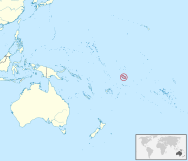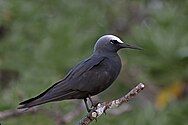List of birds of Tokelau
Tokelau has a moist tropical climate year-round, with an average temperature of 28 °C (82 °F) and a mean annual rainfall of over 3,000 mm (120 in). The atolls consist of coral
This list's
The following tags have been used to highlight several categories. Not all species fall into one of these categories. Those that do not are commonly occurring native species.
- (A) Accidental – a species that rarely or accidentally occurs in Tokelau
- (I) Introduced – a species introduced to Tokelau as a consequence, direct or indirect, of human actions
- (Ex) Extirpated – a species that no longer occurs here although populations may exist elsewhere
Pheasants, grouse, and allies
Order: Galliformes Family: Phasianidae
The Phasianidae are a family of terrestrial birds that consist of
- Red junglefowl, Gallus gallus (I)
Pigeons and doves

Order:
Pigeons and doves are stout-bodied birds with short necks and short slender bills with a fleshy
- Pacific imperial-pigeon, Ducula pacifica
Cuckoos
Order:
The family Cuculidae includes
- Long-tailed koel, Eudynamys taitensis
Plovers and lapwings

Order: Charadriiformes Family: Charadriidae
The family Charadriidae includes the
- Pacific golden-plover, Pluvialis fulva
Sandpipers and allies
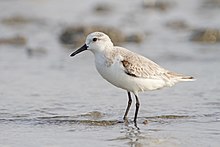
Order:
Scolopacidae is a large diverse family of small to medium-sized shorebirds including the sandpipers, curlews, godwits, shanks, tattlers, woodcocks, snipes, dowitchers, and phalaropes. The majority of these species eat small invertebrates picked out of the mud or soil. Some species have highly specialised bills adapted to specific feeding strategies.[11]
- Bristle-thighed curlew, Numenius tahitiensis
- Whimbrel, Numenius phaeopus (A)
- Bar-tailed godwit, Limosa lapponica
- Ruddy turnstone, Arenaria interpres
- Sanderling, Calidris alba
- Wandering tattler, Tringa incana
Gulls, terns, and skimmers

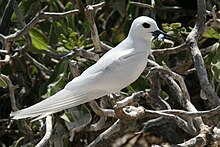
Order: Charadriiformes Family: Laridae
Laridae is a family of seabirds consisting of
- Brown noddy, Anous stolidus
- Black noddy, Anous minutus
- Blue-gray noddy, Anous cerulea (A)
- White tern, Gygis alba
- Sooty tern, Onychoprion fuscatus
- Gray-backed tern, Onychoprion lunatus
- Black-naped tern, Sterna sumatrana
- Great crested tern, Thalasseus bergii
Tropicbirds
Order:
Tropicbirds are slender white birds of tropical oceans, with exceptionally long central tail feathers. Their heads and long wings have black markings.[13]
- White-tailed tropicbird, Phaethon lepturus
- Red-tailed tropicbird, Phaethon rubricauda
Shearwaters and petrels
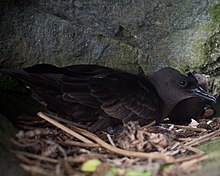
Order: Procellariiformes Family: Procellariidae
The procellariids are a group of medium-sized petrels, characterised by united nostrils with medium
- Southern giant-petrel, Macronectes giganteus (A)
- Bulwer's petrel, Bulweria bulwerii (A)
- Flesh-footed shearwater, Ardenna carneipes
- Wedge-tailed shearwater, Ardenna pacificus (A)
- Christmas shearwater, Puffinus nativitatis (A)[2]
- Tropical shearwater, Puffinus bailloni
Frigatebirds
Order:
Frigatebirds are large seabirds usually found over tropical oceans. They are large, black and white or completely black, with long wings and deeply forked tails. The males have coloured inflatable throat pouches. They do not swim or walk and cannot take off from a flat surface. They are essentially aerial, able to stay aloft for days at a time.[15]
- Lesser frigatebird, Fregata ariel
- Great frigatebird, Fregata minor
Boobies and gannets

Order: Suliformes Family: Sulidae
The sulids comprise the gannets and boobies. Both groups are medium to large coastal seabirds that plunge-dive for fish.[16]
- Masked booby, Sula dactylatra (A)
- Brown booby, Sula leucogaster
- Red-footed booby, Sula sula
Herons, egrets, and bitterns
Order:
The family Ardeidae contains the bitterns, herons, and egrets. Herons and egrets are medium to large wading birds with long necks and legs. Bitterns tend to be shorter necked and more wary. Members of Ardeidae fly with their necks retracted.[17]
- Pacific reef-heron, Egretta sacra
Barn-owls
Order:
- Australian masked-owl, Tyto novaehollandiae (Ex)
See also
References
Specific
- ^ from the original on 16 April 2022. Retrieved 14 April 2022.
- ^ a b c Pierce, Ray; Gruber, Monica; Atherton, James; Burne, Allan; Valu, Mere; Whistler, Art (2012). A Conservation Survey of Tokelau (PDF). Speewah, Queensland. pp. 8–11. Archived (PDF) from the original on 21 April 2021. Retrieved 16 April 2022.
{{cite book}}: CS1 maint: location missing publisher (link) - . Retrieved 16 April 2022.
- . Retrieved 16 April 2022.
- . Retrieved 16 April 2022.
- ISSN 0301-4223.
- S2CID 216315583. Retrieved 16 April 2022.
- S2CID 216304444. Retrieved 16 April 2022.
- S2CID 241787139. Retrieved 16 April 2022.
- S2CID 216164780. Retrieved 16 April 2022.
- S2CID 216445504. Retrieved 16 April 2022.
- ISBN 0-2281-0119-0.
- S2CID 243054855. Retrieved 16 April 2022.
- S2CID 216494761. Retrieved 16 April 2022.
- S2CID 242682341. Retrieved 16 April 2022.
- S2CID 216477098. Retrieved 16 April 2022.
- S2CID 216231772. Retrieved 16 April 2022.
- S2CID 216437168. Retrieved 16 April 2022.
General
- Lepage, Denis. "Checklist of Birds of Tokelau". Bird Checklists of the World. Avibase. Retrieved 30 August 2021.
- Clements, James F.; Schulenberg, Thomas S.; Illif, Marshall J.; Billerman, Shawn M.; Fredericks, T. A.; Gerbracht, J. A.; Lepage, Daniel; Sullivan, Brian L.; Wood, Christopher L. (2022). The eBird/Clements Checklist of Birds of the World: v2022. Cornell University Press.

